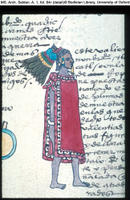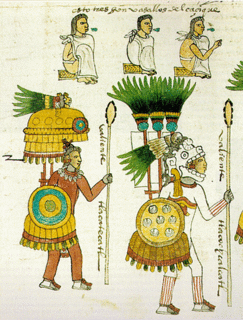 The sixteenth-century Codex Mendoza is an extraordinary document, for aesthetic, formal, and historical reasons.
The sixteenth-century Codex Mendoza is an extraordinary document, for aesthetic, formal, and historical reasons. Most likely commissioned by Viceroy Mendoza, with its images produced by indigenous scribes and informants, then annotated by the Spanish, the document is a key source for our understanding of Aztec culture and society, not least because so few codices survived the conquest, but also because this one was specifically produced as what Mary Louise Pratt would term an "autoethnography": an attempt by the indigenous to record and describe their own way of life and translate this understanding for outsiders' benefit.
Formally, therefore, the document is a fascinating hybrid of pictorial representation, glyphic or symbolic visual codes (from the curlicues to depict speech to the stylized images of dwellings or the multiple eyes that are to signify "night"), annotations of these same images, and then prose interpretations of image sequences or entire pages. It's a collaborative work, arguably perhaps the first Latin American testimonio.
Aesthetically, what's striking is above all the colour and vibrancy of the images, particularly the depictions of the various ranks, honours, and wardrobes of warriors, priests, spies, and so on, all of which indicate a fantastic aesthetic sense that must have permeated Aztec society itself. The various patterns employed on clothing, shields, and headdresses indicate a desire to differentiate between functions and achievements as spectacularly as possible.

No doubt some of this formalization is misleading just as, one would expect, is the extreme rigour and mechanism of the section on child-rearing. As with the Popol Vuh, our knowledge of pre-Columbian America is hostage to the desires of those who were best-placed to present themselves as its legitimate representatives, and who also had most to gain from the perpetuation of pre-existing hierarchies. It's significant how much of the text deals with discipline and punishment: of recalcitrant children ("a 9-year old boy is pierced in his body with maguey spikes by his father, for being incorrigible"), of wayward apprentices ("if the youth roamed about as a vagabond, the two masters punished him by shearing him and singeing his head with fire"), or of rebel caciques ("summoned to war for his rebellion against the lord of Mexico"). Imagine if the only texts that survived to attest to Western cultural achievement were Doctor Spock, Debrett's, and the Southern Baptist Church's rulings on moral degeneracy.
What's interesting, too, but somewhat undecideable, is the extent of the mistranslation or misinterpretation in the constitution of meaning from indigenous codes to Spanish narrative. Its noticeable, for instance, that the prose interpretation uses the term "mezquita" or "mosque" to describe Aztec temples, so demonstrating the extent to which the Spaniards understood their encounters with indigenous civilization within a framework determined by their lengthy interaction with the Arab world.
The document's concluding annotation admits to the limits of European knowledge: "The reader must excuse the rough style in the interpretation of the drawings in this history, because the interpreter did not take time or work at all slowly." Its author goes on to provide a series of errata, and an indication of Spanish dependence upon native informants. The comment also, significantly, alludes to disagreements among these informants as to how Aztec society should be portrayed: "he interpreted it carelessly because the Indians came to agreement late; and so it was done in haste and he did not improve the style suitable for an interpretation" (my emphasis).
Finally, it's worth saying something about the codex's convoluted material history: seized by French corsairs (pirates!) who intercepted the Spanish fleet, it was first taken to the French court and then sold to Richard Hakluyt, the English writer whose work was used by Shakespeare as the source for his own colonial fable, The Tempest. Eventually it ended up in Oxford's Bodleian library.
So this colourful work of indigenous scribes fed Europe's (still) voracious but also unsettling appetite for images and approximations of indigeneity. It remains a vehicle for translation, but also a marker of the fissures that necessarily attend all (auto)ethnographies. The colour endures, standing in for and obscuring the social conflicts that didn't survive transfer to representational form.
6 comments:
But we are not Aztecs, we are Mexicas. Aztecs were antecesors, but we have little to do with them. I think that if you have such a great entry and explanation about the codex and our culture, then we should be addressed acordingly.
Ah yes, I'm from Mexico, I'm a Nahua.... (=
Thanks for your entry!!
we shouldnt allow unscrupulous historians to label us as AZTECS because we know we are MEXICAZ.they know we are MEXICAZ and they know we are the ones that established one of the greatest civilization in the face of the earth...if we were capable once we have the potential again to rule ourselves for ourselves....regretably they've taught our own people these lies and then our own people teach it to our kids without ever researching the facts and the reason why they were fed these lies is so that by calling us aztecs we dont feel like the inhumane crimes were committed against us MEXICAZ but another tribe....MEXICO is MEXICATL....not aztec..the evidence is all over america but they choose to ignore it and give us true credit because this will raise our selfesteem and give us strength after five hundred years of submission and recognize that what was done to us has no name and no place in the eyes of the GOD...genocide and thievery will always be crimes and the peoples that commit them are just that.....not heroes.........
I'm taking a class called the Aztecs right now and the first thing the professor clarified is that Aztec was a name given by the Spanish to the Mexica. I'm glad professor are up front about it. No one in class really refers to them as the Aztec. FYI: It is our duty to look for the truth hence our interest in these documents...we only believe what we choose to.
www.lampungservice.com
lampungservice.com
Indonesian Courses
Komponen HP
Cara Menghidupkan HP Mati Total Baterai Tanam
Macam Macam IC
Cara Memperbaiki LCD
Lembaga Kursus Terbaik Indonesia
Cara Menghidupkan HP Mati Total
Youtube
Thanks foor writing
This is an incredibly fascinating look into Aztec culture and society.
Post a Comment